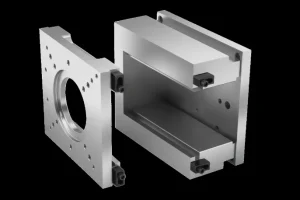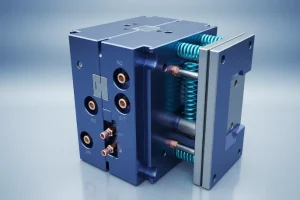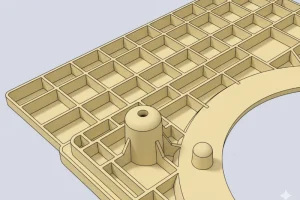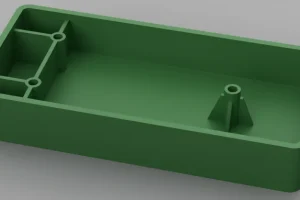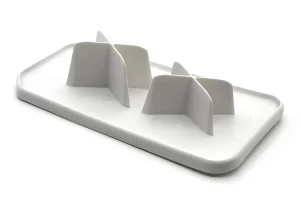Introduction: Metal injection molding (MIM) is like this cool thing where they combine plastic injection molding and powder metallurgy. They mix metal powder with a polymer binder, melt it, and shoot it into a mold using a regular injection molding machine.
Then it cools and hardens into the shape you want. People use the final product in all kinds of industries, like medical, dental, aerospace, and cars. The metal injection molding process is different from traditional manufacturing methods.

It represents an advanced and efficient manufacturing technology suitable for the manufacture of metal parts that require high precision, complex geometry or large-scale production . This article mainly explores metal injection molding.
What is MIM?
metal injection molding combines traditional plastic injection molding and powder metallurgy processes.which is a way to mix metal powder and binder for injection molding.

First, you mix the powder you want with a binder. Then you make little balls out of the mix and shoot it into the shape you want. You take out the binder by burning it off and then you have the metal part you want, or you can do more stuff to it like mold it again, make it look better, heat it up, or cut it up to make it even better.
MIM = Powder Metallurgy + Injection Molding
MIM is a typical cross-disciplinary product. It integrates two completely different processing technologies (powder metallurgy and plastic injection molding) to enable engineers to break free from traditional constraints and obtain low-priced, special-shaped stainless steel, nickel, iron, copper, titanium and other metal parts through plastic injection molding, so it has greater design freedom than many other production processes.

What is the MIM Process?
The steps of metal injection molding are: first, choose metal powder that meets the requirements of metal injection molding and mix it with an organic binder at a certain temperature by a suitable method to make a uniform feed, then after granulation, use an injection molding machine to inject it into the mold cavity under a heated plastic state to get a formed blank, then degrease it by chemical or solvent extraction, and finally get the final product by sintering and densification.
Metal Powder
The particle size of metal powder used in the metal injection molding process is generally 0.5 to 20 micrometers. In theory, the finer the particles, the larger the specific surface area, and it is easier to mold and sinter. The traditional powder metallurgy process uses coarser powder larger than 40 micrometers.

Organic Adhesive
The organic adhesive is used to bond the metal powder particles, so that the mixture has rheological and lubricating properties when heated in the barrel of the injection machine, that is, it is a carrier that drives the powder to flow.

Therefore, the selection of adhesive is the key to the entire powder injection molding. Requirements for organic adhesives: small dosage, that is, using less adhesive can make the mixture have better rheological properties; non-reactive, no chemical reaction with metal powder during the removal of the adhesive; easy to remove, no carbon residue in the product.
Mixing And Granulation
When mixing, the metal powder and organic adhesive are mixed together evenly to adjust their rheological properties to the state suitable for injection molding.

The uniformity of the mixture directly affects its fluidity, thereby affecting the injection molding process parameters and even the density and other properties of the final material. The scraps and waste generated during the injection molding process can be crushed, granulated, and recycled.
Injection Molding
The process of this step is basically the same as the plastic injection molding process, and the equipment conditions are basically the same.

During the injection molding process, the mixture is heated in the barrel of the injection machine to form a plastic material with rheological properties, and injected into the mold under appropriate injection pressure to form a blank. The density of the injection molded blank should be uniform at the microscopic level so that the product shrinks evenly during the sintering process.

Controlling molding parameters such as injection temperature, mold temperature, injection pressure, and holding time is crucial to obtaining a stable green weight. It is necessary to prevent the separation and segregation of the components in the injection material, otherwise it will lead to dimensional loss and distortion and scrap.Debonding
The organic binder in the molded blank must be removed before sintering. This is called debonding. The debonding process must make sure the binder is gradually discharged from different parts of the blank along the tiny channels between the particles without reducing the strength of the blank.

After the solvent extracts part of the binder, the remaining binder must also be removed by thermal debonding. During debonding, the carbon content in the blank must be controlled and the oxygen content must be reduced.
Sintering
Sintering is done in a sintering furnace with a controlled atmosphere. The high density of MIM parts is achieved by high sintering temperature and long sintering time, which greatly enhances and improves the mechanical properties of the part material.

Post-Processing
For parts with more precise dimensional requirements and special performance requirements, you need to do some post-processing. This process is the same as the heat treatment process of conventional complex shaped metal components.
What are the Advantages of MIM?
MIM combines the advantages of powder metallurgy and plastic injection molding. It breaks through the limitations of traditional metal powder molding processes in product shape. It uses plastic injection molding technology for mass production and efficient forming of complex-shaped parts. It has become a near-net forming technology for modern manufacturing of high-quality precision parts.

It has incomparable advantages over conventional powder metallurgy, machining, and precision casting.cnc machining can be used for secondary processing of MIM parts, such as hole machining, thread machining, surface grinding, etc., to meet specific engineering requirements.
Highly Complex Parts that Can be Formed
Compared to other metal forming processes like sheet metal stamping, MIM can make parts with really complex shapes.

MIM can also make the same complex shapes that plastic injection molding can make.
Because of this, MIM can make parts that used to be made by other metal forming processes all in one piece.

This makes the design of the part easier, makes the part cheaper, and makes the part easier to put together.cnc machining can be used for secondary processing of MIM parts, such as hole machining, thread machining, surface grinding, etc., to meet specific engineering requirements.
High Material Utilization Rate
MIM forming is a near-net forming process. The shape of its parts is close to the final product form, and the material utilization rate is high, which is particularly important for the processing loss of precious metals.

porous metal techniques and metal injection molding processes may complement and develop each other at the intersection of material manufacturing and application, pushing material manufacturing technology towards a more efficient and complex direction.
The Microstructure of the Parts is Uniform, the Density is High, And the Performance is Good
MIM is a process that makes things out of liquid. The glue makes the powder stick together so that the thing you make doesn’t have holes in it. Then you can make the thing you make as heavy as it’s supposed to be.

Usually, MIM makes things that are 95% to 99% heavy. If you make things heavy, they get stronger. They also get tougher, stretchier, and better at carrying electricity and heat. They also get better at being magnets.
The density of parts pressed by traditional powder molding can only reach 85% of the theoretical density at most. This is mainly due to the friction between the mold wall and the powder and between the powders, which makes the pressing pressure unevenly distributed, resulting in uneven microstructure of the pressed blank.

This will cause the pressed powder metallurgy parts to shrink unevenly during the sintering process, so the sintering temperature has to be lowered to reduce this effect, resulting in large porosity, poor material density, and low density of the products, which seriously affects the mechanical properties of the parts.
High Efficiency, Easy to Achieve Mass and Large-Scale Production
MIM uses injection molding machines to mold product green billets, which greatly improves consumption efficiency and is suitable for mass production; at the same time, the consistency and repeatability of injection molding products are good, which provides a guarantee for mass and large-scale industrial production.

Metal injection molding technology has significant advantages in manufacturing soft magnetic alloys parts, and can meet the requirements of complex shapes and high precision, while reducing production costs and improving production efficiency.
Wide Range of Applicable Materials And Broad Application Fields
There are a lot of metal materials that can be used for MIM. Basically, any powder material that can be cast at high temperature can be made into parts by MIM, including materials that are hard to process and materials that have high melting points in traditional manufacturing process.

The metal materials that can be processed by MIM include low alloy steel, stainless steel, tool steel, nickel-based alloy, tungsten alloy, cemented carbide, titanium alloy, magnetic material, Kovar alloy, precision ceramics, and so on.
Also, MIM can do material formula research according to user requirements, make alloy materials of any combination, and make composite materials into parts.

MIM molding of non-ferrous alloy aluminum and copper is technically feasible, but it is usually done by other more economical methods, such as die casting or machining.
What are the Characteristics of MIM Products?
Complexity
MIM, like injection molding, has no shape restrictions. Since MIM is a molding process, adding features doesn’t add cost, making MIM a great way to combine parts into multifunctional products. MIM design rules are very close to injection molding, making it suitable for almost all products.

Precision
The reference design of MIM net molding accuracy is usually ± 0.5% of the size. Net molding of some features can reach ± 0.3%. Like other technologies, the higher the accuracy requirement, the higher the cost, so moderate relaxation of tolerance requirements is encouraged if quality allows. Tolerances that cannot be achieved with MIM in one pass can be achieved with the help of surface treatment.
Weight And Size
MIM is great for parts under 100 grams, and under 50 grams is the most cost-effective. However, parts up to 250 grams can be made. The main cost of MIM is the raw material, so MIM uses new technologies to reduce the weight of the parts as much as possible.

Like plastic parts, the weight of the parts can be reduced by using cores and brackets without affecting the integrity of the product. MIM is great for very small and micro parts, and weights under 0.1 grams are possible. Weight is not a limiting factor, and parts over 250mm long can be made.
Thinning
For MIM, wall thicknesses of less than 6 mm are best. You can go thicker, but it’ll cost more because it takes longer and you’ll use more material. You can also go thinner, down to 0.5 mm, but it’s harder to design.

Production
MIM is a super flexible process, and you can make thousands to millions of parts per year very cheaply. Like castings and injection molding, MIM requires you to buy molds and tooling, so for small quantities of parts, it usually affects the cost.
Raw Materials
MIM can process a lot of stuff, like ferroalloys, superalloys, titanium alloys, copper alloys, refractory metals, cemented carbides, ceramics, and metal particles matrix composites. Aluminum and copper non-ferrous alloys are technically possible, but they’re usually done by other cheaper methods, like die casting or machining.

What are the Applications of MIM?
MIM is used in consumer electronics, automotive parts, medical devices, power tools, industrial equipment, and daily necessities.
Consumer Electronics
Consumer electronics products typically include smartphones, tablets, laptops, digital cameras, smart wearables, drones, etc.

In 2010, the MIM process technology was used in the appearance of the BlackBerry mobile phone’s signage, which opened the mass application of MIM parts in mobile phones.
Apple has also started using MIM parts since 2010, and has been expanding and leading the application scope of MIM. MIM parts such as power interface parts, card trays, hinges, camera rings, buttons, etc. have been successfully used on mobile phones.

As smartphones and smart wearables get lighter and thinner, the stuff inside them gets more refined and complicated. That’s why MIM is going to be a big deal.
Automotive Parts
In the field of automotive parts manufacturing, MIM technology is a non-cutting metal parts forming process that can save materials and reduce production costs. Therefore, MIM technology has received great attention from the automotive industry and began to be used in the automotive parts market in the 1990s.

Right now, the car industry is using MIM technology to make some complex-shaped, bimetal parts and grouped micro-small parts, like turbocharger parts, regulating rings, fuel injector parts, blades, gearboxes, power steering parts, and so on.
Medical Devices
In the medical device field, the medical accessories consumed by the MIM process are of high precision and can meet the requirements of small size, high complexity, high mechanical properties and other requirements of accessories required by most fine medical devices.

In recent years, the application of MIM technology has become more and more extensive, such as surgical handles, scissors, tweezers, dental parts, orthopedic joint parts, etc.
Power Tools
Power tool parts processing is very complicated, the processing cost is high, the material utilization rate is low, and the dependence on MIM is high. Typical products include special-shaped milling cutters, cutting tools, fasteners, micro gears, loosening machines/textile machines/crimping machine parts developed in recent years, etc.

Conclusion
Metal injection molding (MIM) is a fancy way to make stuff. It’s like a mix of powder metallurgy and plastic injection molding. You mix metal powder and some other stuff to make a paste. Then you squirt it into a mold. After that, you get rid of the other stuff and heat it up.

When you’re done, you have a metal part that’s really good. People use MIM to make all kinds of things. They use it in medicine, dentistry, space, and cars. You can also use MIM to make things that are hard to make. It’s a good way to make stuff.


